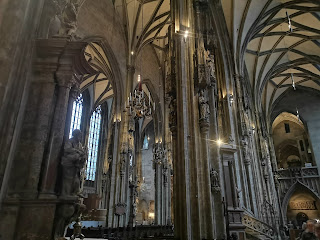The Prater and the Giant Ferris Wheel
Capital of the Republic of Austria and one of Europe's most visited cities, Vienna (Wien) owes much of its charm and rich history to its splendid location on the banks of the Danube River. For centuries the gateway between West and East Europe, it was the natural nucleus of the once sprawling Habsburg Empire, and to this day remains Austria's most important commercial and cultural hub.
Dedicated to St. Charles Borromeo, a saint invoked during times of plague, Karlskirche (St. Charles Church) was built in 1737 and remains Vienna's most important Baroque religious building. This vast building is crowned by a magnificent 72-meter dome and is famous for its twin 33-meter Triumphal Pillars, based on Trajan's Column in Rome, with their spiraling bands depicting scenes from the life of St. Charles. Interior highlights include the fabulous frescoes of St. Cecilia. Be sure to check the church's official website for details of its regular concert program.
Also worth visiting is the Gardekirche, built in 1763 in the city's southern outer district as the church of the Imperial Hospital and later serving Polish congregations (of particular interest is the painting above the High Altar).
Modeled on St. Peter's in Rome, Peterskirche-the Collegial and Parish Church of St. Peter-is built on a site originally occupied by a Roman church and later by one founded by Charlemagne in 792 AD. The present edifice was built in the 18th century and boasts a massive dome with a superb fresco and many artistic treasures.
Other highlights include the Barbara Chapel with its magnificent portal, and in which Franz Karl Remp's Decollation of St. Barbara is found, and the choir with its High Altar and painting of the Immaculate Conception. The church is also noted for its frequent organ recitals.
Also of note is the nearby Plague Pillar, a 21-meter-tall Baroque pillar built to commemorate the end of the devastating plague of 1679 that cost at least 75,000 Viennese their lives. The nearby Abbey of the Scots (Schottenstift), built in the 12th century and extensively renovated and enlarged since, is also worth popping into. Its school included Johann Strauss and Austria's last emperor, Charles I, among its pupils, while its fine collection of artwork includes pieces from the 16th to 19th centuries.

































































No comments:
Post a Comment